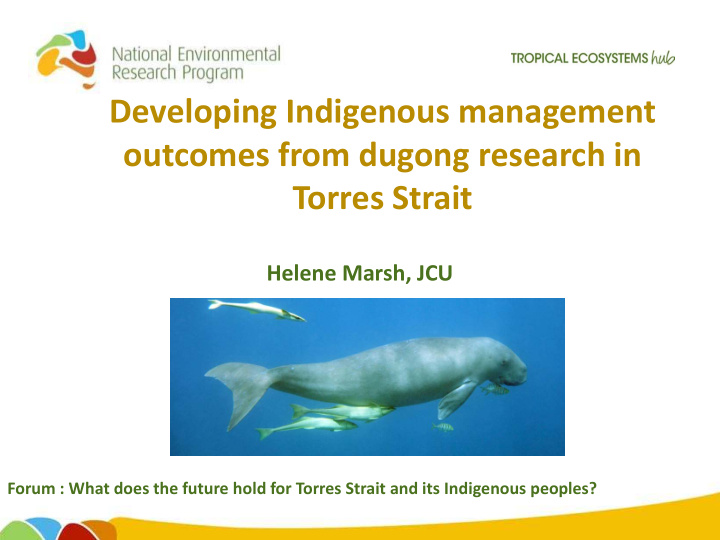



Developing Indigenous management outcomes from dugong research in Torres Strait Helene Marsh, JCU Forum : What does the future hold for Torres Strait and its Indigenous peoples?
Lifespan similar to humans > 70 years First calf at 7-17 years Mandy Etpison photograph Nurse for at least 18 months 2
Low sustainable human-caused mortality Dugong Sustainable human-caused population Survival of adults must mortality per size be > 95% p.a. to year* maintain a dugong 100 0 population Modeling in 2004 1000 <13 suggested harvest may not be sustainable 10000 <130 New research suggests this result not correct *using PBR technique mandatory in US 3
Torres Strait dugongs genetically healthy and connected with east and western Australia David Blair et al. data Mitochondrial DNA Microsatellite DNA Bay Moreton Bay Hervey Qld Central N Qld Strait Torres NT WA Moreton Bay
Torres Strait dugong population apparently stable over 25 years Dugong density per km 2 Marsh et al. 2011 Year Slow declines hard to detect: need good catch data 5
Western Torres Strait: Australia’s: largest continuous seagrass meadow discovered by QDPI/TSRA in 2010 Dugongs Seagrass Seagrass map Helen Taylor; dugong map Alana Grech
Torres Strait: dugong capital Large scale aerial surveys have enabled spatial models of dugong distribution and abundance at huge spatial scales 7 Map drawn by Alana Grech
62% of best dugong areas rarely hunted Grayson (2011) Dugong Sanctuary 38% hunted 40% unofficial sanctuary 22% Dugong 35 40% Sanctuary Community based management 8 Grayson and Grech data
Tracking dugongs from space Mabuiag and Biogu rangers and community members involved in all aspects Islanders provided expert advice and assisted with catching.
Caught on Orman Reef the dugongs moved widely showing need for Informing dugong management by studying co-ordination of management across communities and countries dugong movements Fuentes et al.
Catch monitoring • TSRA established data base and developing catch monitoring as part of Community Management plans • Research by Dr Jillian Grayson shows that using trained Indigenous rangers to monitor catches by interview can reduce reporting burden on hunters and provide accurate results • Methodology being refined in consultation with Professor Ken Pollock
What next? TSRA consulting with Islander leaders and PNG about implementing research recommendations. especially expanding Dugong Sanctuary into PNG waters
Recommend
More recommend